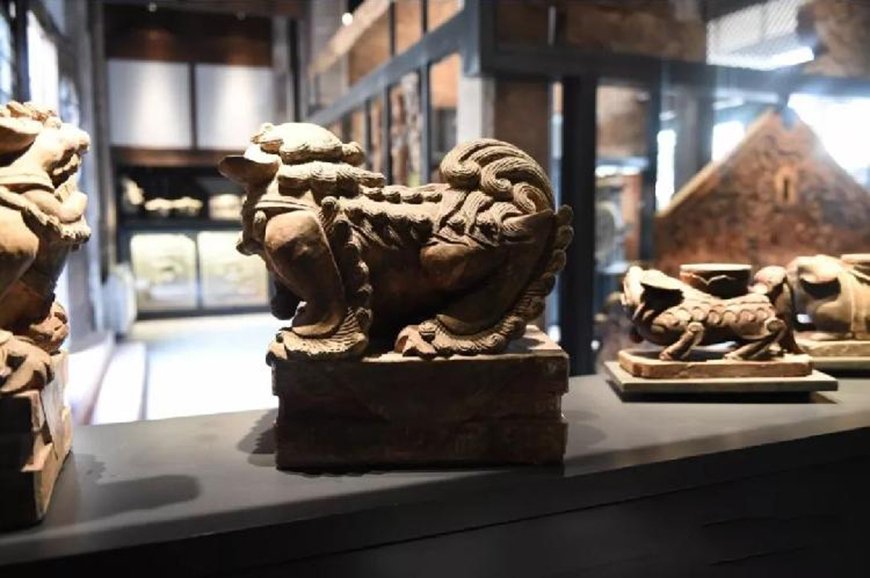The Ba-Shu Ancient Architecture Museum is located at Chenjiaqiao Sub-district, Shapingba District of Chongqing, China, where is now the core area of Chongqing Science City. The Museum is themed on the ancient architectural culture reserved in Sichuan and Chongqing. It is in proximity to the Fuxing Temple, which is a cultural relic under municipal-level protection.
It is reported that it took six years to build this first museum of its kind in Sichuan and Chongqing. The permanent exhibition of the Museum constitutes four sections displaying over one thousand pieces of cultural relics. Most of them are wooden, stone, clay, and brick architectural structures, as well as other unearthed items associated with the ancient architectural culture in the said areas.

Display in Ba-Shu Ancient Architecture Museum
History of the Ancient Architectural Development in the Ba and Shu Areas
The mountains and rivers distributed in the Sichuan Basin bred the ancient architectural culture of the Ba and Shu areas, which carries clearly identifiable local characters and folk cultural elements. This is an exclusive culture embodied in the architecture seen in the mountainous region.
This exhibition section mainly shows the development of the architectural style of the Ba and Shu areas in ancient times, during which the mountainous architecture met against and blended with the adaptive architectural cultures of the surrounding areas lived by immigrated folks.
Meanwhile, Western architecture also left its trail as evidence of the modernization of the architecture in the Ba and Shu areas.

The architecture style in the Song dynasty (model)
Types and Modalities of the Ancient Architectural Culture of the Ba and Shu Areas
The Ba and Shu areas involve large areas, various landforms, and climatic features, as well as the complex composition of ethnicity. The architectural style was formed based on these local features and was enriched by the architectural culture elements brought in by the immigrants from their original localities. Such a blended architectural style is particularly identifiable from the current residences and the guild halls.
The exhibition section displays such a diversity-blending architectural form and style with rich characteristics by historical photos and architectural relics. They highlight local and regional architectural culture.
Among them are some cultural relic pieces and pictures about the city gates, city gate towers, and markets in towns as well as ferryboat docks, which represent the artistic structures like beams and frames that tell the architectural types and modalities.

The opening ceremony of the museum
Decorative Art of the Ancient Architecture in the Ba and Shu Areas
All kinds of traditional techniques constitute an integral part of the Chinese culture, and the decorative carving technique applied in the traditional buildings in the Ba and Shu areas is an essential member of Chinese architectural carving art.
Subtle carving techniques are seen to create all kinds of artistic images in the sense of space and tableau. They tell us the local artistic traditions and the popular aesthetics of ancient times.
In this section, the carved and hollowed patterns on decorative structures of the architecture in the Ba and Shu areas are shown to demonstrate the exquisiteness.
Appreciating them in detail, visitors may find that the patterns are about historical stories, figures in dramas, flowers, plants, and animals that carry the best aesthetic values in the ancient architecture of the Ba and Shu areas.

dragon symbol in the architecture of the Ba and Shu areas
The History and Culture of the Fuxing Temple and the Successful Relocation for Protection
The Museum is built with the locality advantage of the restored Fuxing Temple, which preserves the “soul” of the Museum.
The Fuxing Temple was first built during the reign of Emperor Wanli (1573-1620) of the Ming Dynasty. It has three yards in a horizontal line. The restoration project strictly copied its original appearance without using a single iron nail. The restored Fuxing Temple and the Museum reciprocally reinforce the cultural values of them both.
This exhibition section displays the past and present of the Fuxing Temple, lasting for hundreds of years. The collections in the museum are complete in categories in terms of decorative techniques, which include painting with gold and pigments, porcelain inlay, carving, etc., and are evident in its artistic clues. These collections well exhibit the colorful and original ancient architectural culture in the Ba and Shu areas.
The Ba-Shu Ancient Architecture Museum is the first state-owned special museum themed on ancient architecture in present Sichuan and Chongqing. Its establishment fills in the gap of the museum of this type in Southwest China.
Visitor`s Info
It is currently a soft opening period lasting from October 29, 2019, to January 31, 2020.
Opening Hours: 9:00-12:00 and 13:00-16:30
Transportation: The visitors can take CRT Line 1 to Chenjiaqiao Station and get out of the station at No. 1 Exit, and then turn right and walk about 900 meters to arrive.
